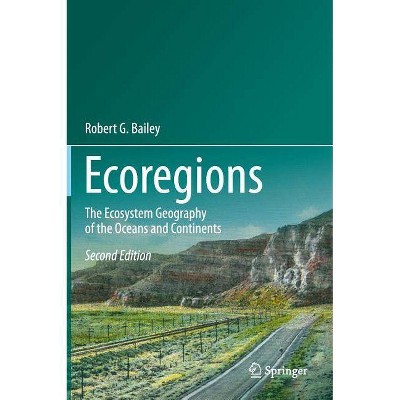Ecoregions - 2nd Edition by Robert G Bailey (Hardcover)

Similar Products
Products of same category from the store
AllProduct info
<p/><br></br><p><b> About the Book </b></p></br></br>This book offers an invaluable source of description, interpretation and analysis of global patterns of ecosystem distribution and successfully provides the reader with the means of making sense of these patterns.<p/><br></br><p><b> Book Synopsis </b></p></br></br>Global warming and human-driven impacts are changing the World's ecological zones. This book applies the principles described in Bailey's Ecosystem Geography: From Ecoregions to Sites, 2nd ed. (Springer 2009, 1st ed. 1996) to describe and characterize the major terrestrial and aquatic ecological zones of the Earth. Bailey's system for classifying these zones has been adopted by major organizations such as the U.S. Forest Service and The Nature Conservancy and this book is a significant contribution to a long tradition of classifying and studying the world's ecological regions or ecoregions. It includes two color maps that show the major ecoregions of the continents and oceans. Also included are: - 106 illustrations with 55 in full color - A new chapter on mountains is included. - There are new sections that address concerns about how eco regions are changing under the relentless influence of humans and climate change - Another new feature is the discussion of using eco regional patterns to transfer research results and select sites for detecting climate change effects on ecosystem distribution - Use of ecoregional patterns to design monitoring networks and sustainable landscapes - Fire regimes in different regional ecosystems and their management implications.<p/><br></br><p><b> From the Back Cover </b></p></br></br><p>The first edition of this book (1998) classified and characterized the regional-scale ecosystem units (ecoregions) of the Earth as shown on a map that Bailey developed with the encouragement of several international organizations. In addition to the descriptive account, his primary goal was to suggest explanations of the mechanisms that act to produce the world pattern of ecoregion distribution, and to consider some of the implications for land use. He included ocean types, since understanding land regions depends on understanding ocean systems. </p><p>The increasing importance of ecoregions is confirmed by the fact that much planning, research, and management efforts by the US Forest Service, The Nature Conservancy, World Wildlife Fund and other organizations are taking place now within the framework of ecoregions. Over years since the book was first published a number of studies have greatly contributed to a better understanding of the Earth's ecoregions. This second edition is a completely updated and expanded version. New sections address how ecoregions are changing under the relentless influence of humans (such as modification of fire regimes and the introduction of invasive species) and climate change, the use of ecoregional patterns to transfer research results and select sites for detecting climate change effects on ecosystem distribution, and the use of ecoregional patterns to design monitoring networks and sustainable landscapes.</p><p><i>From the reviews of the 1st edition: </i></p><p>"Ecoregions offers an invaluable source of description, interpretation and analysis of global patterns of ecosystem distribution and successfully provides the reader with a means of making sense of these patterns." -<i>Geography</i></p><p>"... this volume provides two major advances over previous works ... Bailey realizes that understanding continental systems requires a grasp of the enormous influence that ocean systems and mountain building exert on terrestrial climatic patterns..." -<i>The Quarterly Review of Biology</i></p><p><i>About the Author: </i></p><p><b>Robert G. Bailey</b> is a geographer with the United States Forest Service, Rocky Mountain Research Station, Inventory and Monitoring Program, in Fort Collins, Colorado, and the former leader of the agency's Ecosystem Management Analysis Center. His work involves the application of ecosystem geography to ecological planning and design.</p><p/><br></br><p><b> Review Quotes </b></p></br></br><br><p>From the book reviews: </p><p>"This work remains a necessary resource for basic research in environmental science, management, and program development. It can serve as a textbook or reference for students in relevant programs such as geography, ecology, and resource management. Summing Up: Highly recommended. Upper-division undergraduates and above." (J. Chen, Choice, Vol. 52 (4), December, 2014)</p><br><p/><br></br><p><b> About the Author </b></p></br></br>Robert G. Bailey, born in 1939, received his PhD in Geography from the University of California, Los Angeles in 1971. An ecological geographer with U.S. Forest Service, Rocky Mountain Research Station, he was leader of the agency's Ecosystem Management Analysis Center for many years. He has four decades of experience working with the theory and practice of ecosystem classification and mapping and its application to management. He is author of numerous publications on this and related subjects, including four books.
Price History
Price Archive shows prices from various stores, lets you see history and find the cheapest. There is no actual sale on the website. For all support, inquiry and suggestion messages communication@pricearchive.us




















